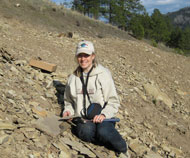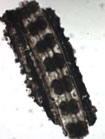 |
|||||
| Biology Home Page | News | Calendar | Make a Gift | |||||
|
Fall 2008 | Return to issue home
The Evolution of an Indispensable Ecosystem By Kristy Brady There are many different ecosystems on the planet, ranging from the cold, dry tundra of high latitudes to the warm, wet rainforests near the equator. In the middle of these two extremes are grasslands, which cover one quarter of the total land surface area. And they are prime human habitat, with about one billion people living in grasslands around the world. More significantly, grasses (e.g., rice, corn, wheat) comprise a substantial proportion of caloric intake for humans, well-over 50% in most countries. So it’s little wonder why understanding the nature and evolution of grasses and grasslands is important. And this is the focus of Biology assistant professor Caroline Strömberg’s paleobotanical research: understanding the origin of grasses, their diversification and range expansion, and coevolution with grazers.
Caroline has investigated these topics all over the world. She has worked in Europe, Asia Minor, China, South America, North America, and to some extent in Africa, Tibet, and India. In all of these places there was an expansion of grasslands at some point in history. An initial expansion of cool-temperate grasses took place in many of these areas at least 20-25 million years ago. About 7-8 million years ago, a second expansion of tropical grasses occurred at lower latitudes. It is thought that the catalyst for these two major grassland expansions was considerable changes in climate. However, whether the relevant climatic changes were regional or global is still unknown. Similarly, which climatic elements changed (e.g., precipitation, temperature) is also not yet known. Solving such mysteries is a collaborative process involving paleobotanists, sedimentologists, isotope geochemists, and climatologists to name a few. Here is a very simplified version of how a research project might work: paleobotanists collect data such as changes in vegetation type over a certain time frame. Isotope geochemists record changes in the isotopic composition of soil or rock layers reflecting the same time frame. Climatologists build models incorporating various parameters such as global sea surface temperature and landmass distribution in order to recreate possible temperature and precipitation patterns on land during the same time. Then the scientists make predictions about what vegetation should have looked like, or isotope composition should have been, given the climate created by the model. If the outcome does not match the real-life data collected, the model’s parameters are adjusted and they try again. Ultimately, the model allows the researchers to determine which climate process(es) yielded the vegetation type and isotope patterns recorded. This whole process works because certain types of plants are very climatically sensitive, so exist only given certain environmental conditions. Similarly, changes in the isotopic composition of certain elements reveal changes in temperature or aridity. A few years ago Caroline and several of her colleagues documented the existence of grasses more that 65 million years old. This was a monumental discovery because it proved that grasses are at least 30 million years older than previously thought and existed during the time of the dinosaurs. Notably, this discovery may explain the existence of gondwanatherians, mammals with teeth that looked very similar to (grass-eating) horse teeth. Gondwanatherians existed during the late Cretaceous and the apparent presence of grass-eating animals living prior to the origin of grasses posed an interesting conundrum for paleobiologists for many years.
Caroline has also studied the evolutionary response of animals to the spread of grasslands. Recently she studied the evolution of horses in the Great Plains of North America and found that the changes in tooth shape and durability that permitted horses to feed on grass evolved several million years after grassland expansion in the Plains. This is interesting because it means that at least some animals adapt more slowly to large-scale environmental changes than previously thought. Now in the Pacific Northwest, Caroline plans to extend her research on grasslands to this part of the world. The coastal climate west of the Rockies is significantly different from the interior continental climate east of the Rockies; so comparing the evolution of grasslands in these two disparate climatic environments should be interesting. Additionally, it is known that large-scale floral changes occurred in the Pacific Northwest around 35 million years ago during the transition between the Eocene and Oligocene eras. During this transition, the climate cooled significantly. Caroline describes the change as “going from a greenhouse to an icehouse”, a change that would undoubtedly drastically alter species compositions and vegetation structure. Recent research suggests the drop in temperature during the Eocene-Oligocene transition occurred as a result of decreased levels of carbon dioxide in the atmosphere. This is an interesting discovery in light of the present day concern that increasing carbon dioxide in the atmosphere may trigger dramatic increases in global temperatures. Because it is difficult to conduct climate-related experiments on a meaningful spatial or temporal scale, paleobiology research is exceedingly important for revealing cause and effect relationships. For instance, Caroline’s research on how a past cooling event affected vegetation structure can answer many questions, such as which types of plants (e.g., trees) dropped out of the ecosystem when the climate changed? Which types of plants increased in abundance following the change? Such knowledge can then be paired with similar fauna data. Like filling in the pieces of a puzzle, new data add to our understanding of the cause and effect dynamic of changing abiotic conditions. Understanding past examples of this dynamic informs us of how future changes in climate may alter ecosystems. And presently this is something that everyone wants to know more about. For more information on Caroline’s research, visit her Web site. Fall 2008 | Return to issue home | |||||
|
|||||


